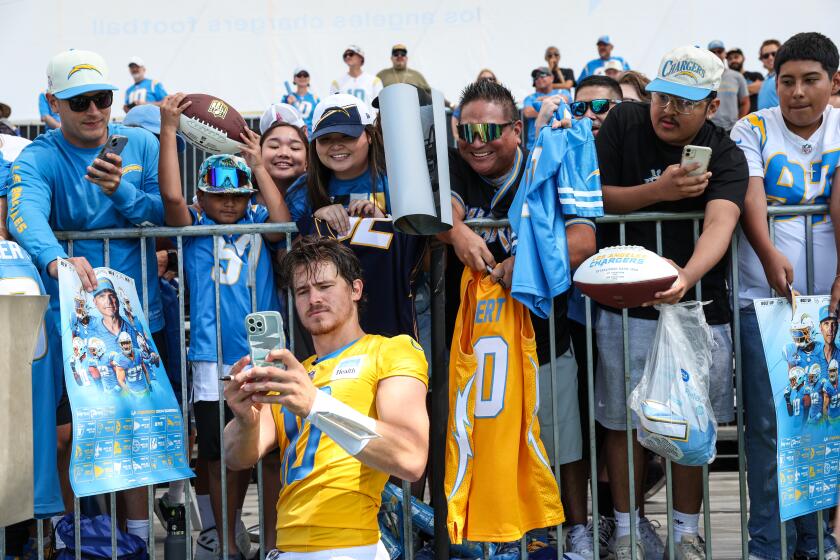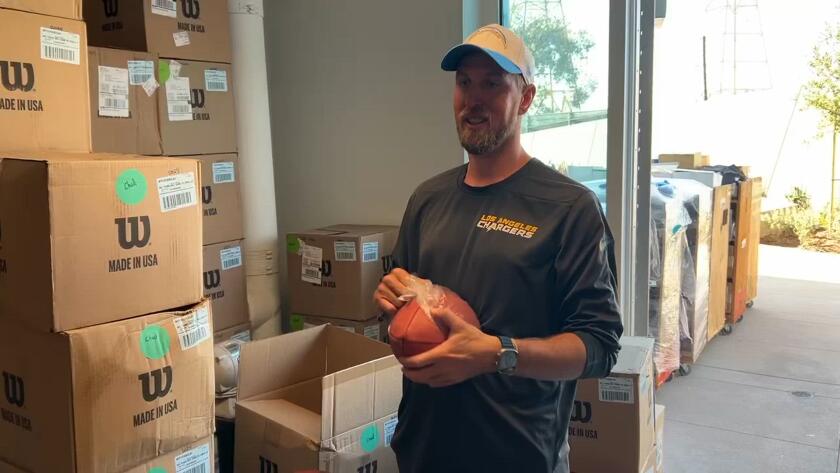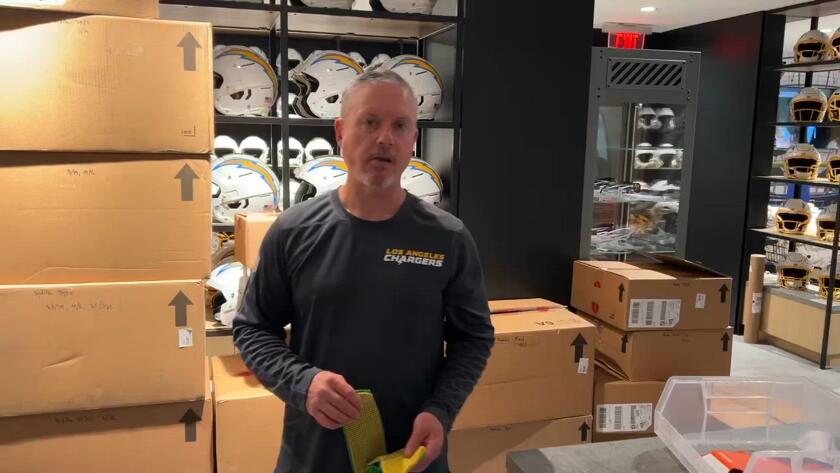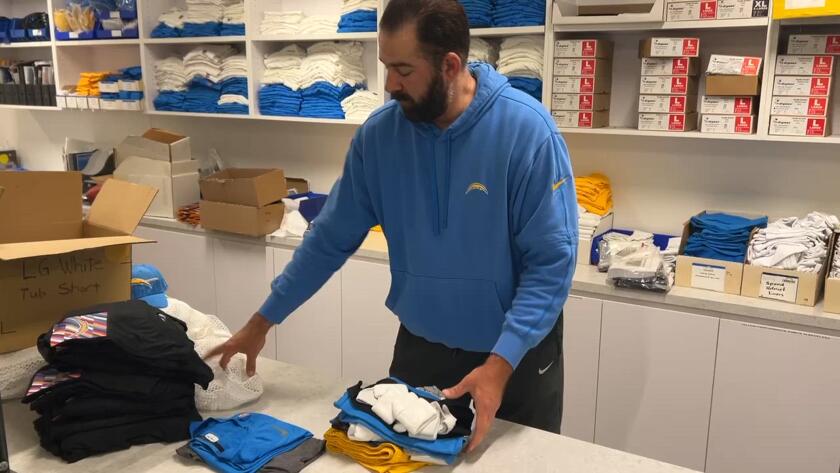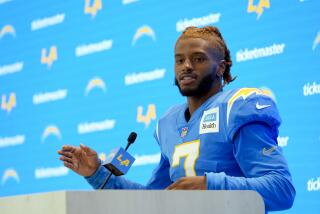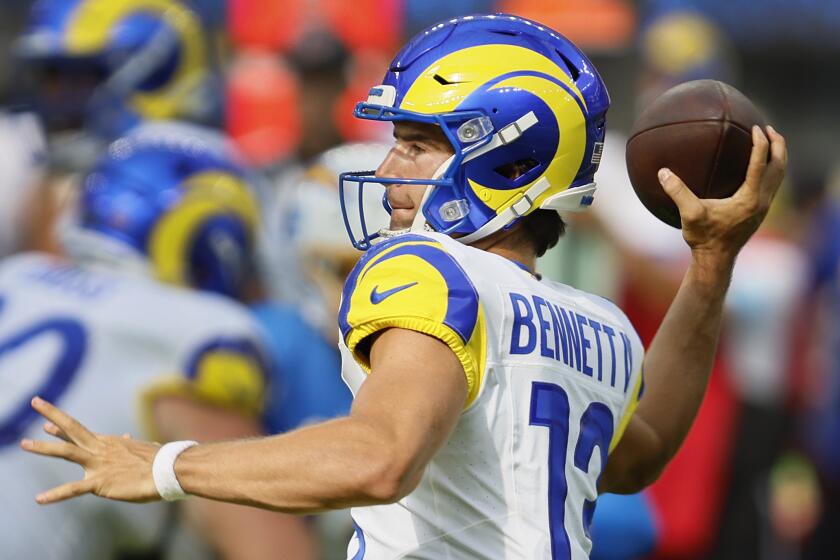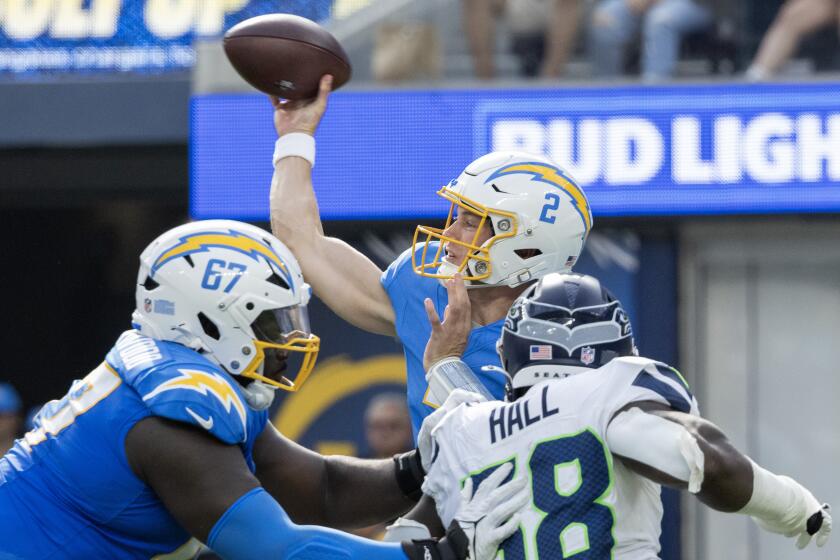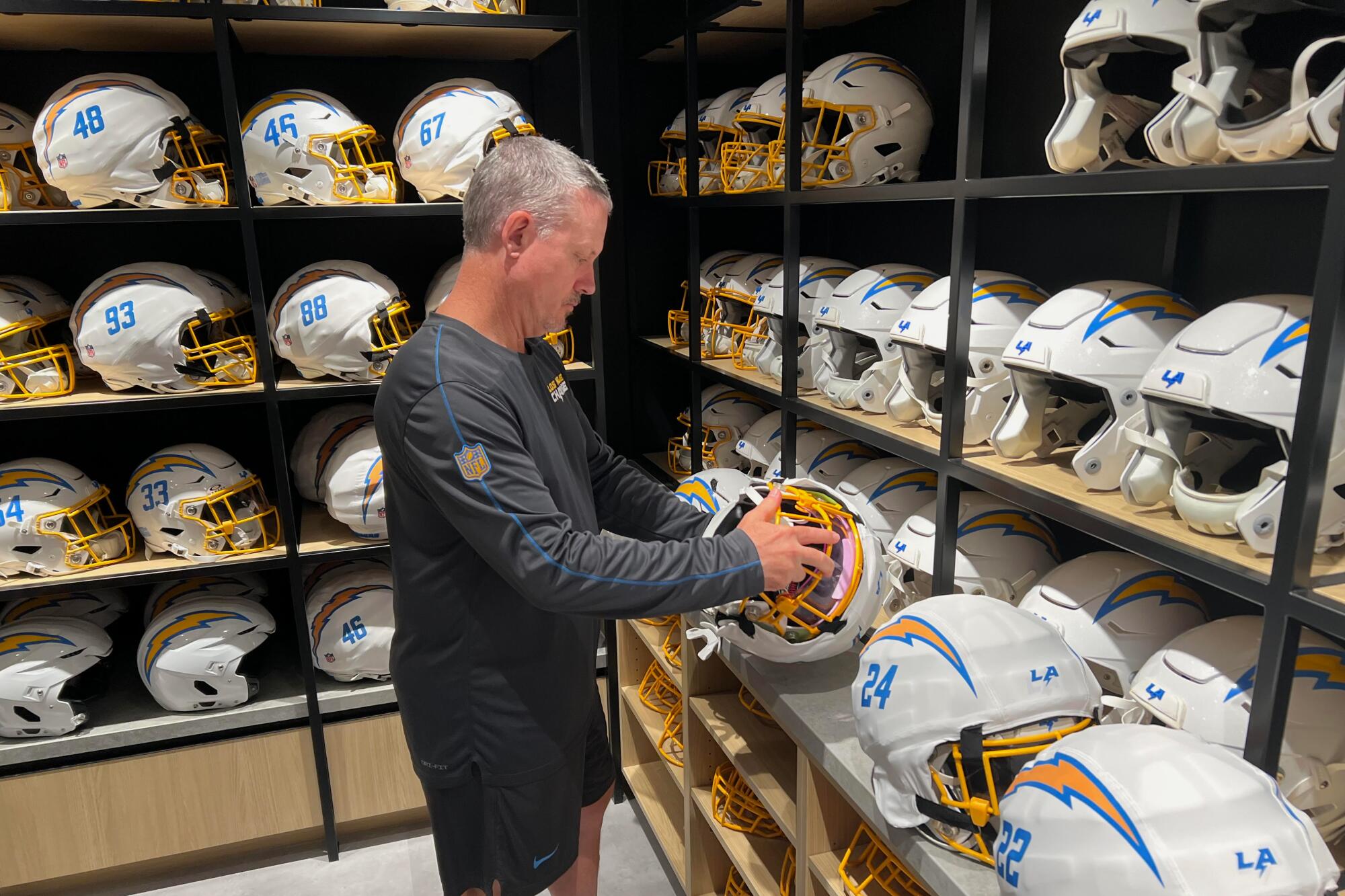
Chris Smith didn’t just saunter into his position as director of equipment operations for the Chargers. His career started at the ground floor.
As in the grass under his feet.
“We had a blank grass field at UC San Diego, and Sid said, ‘Oh, if you didn’t know, you’re painting the fields out there for training camp,’” said Smith, 58, referring to legendary equipment manager Sid Brooks, who was with the Chargers from 1973 to 2000 before a five-year stint at USC.
“I had never painted a football field in my life. So he handed me a schematic of a football field, and I had a group of four high school kids that were there to help me, and I had to figure it out. … And we did it.”
Chargers injured quarterback Justin Herbert had the protective boot removed from his right foot, moving him a step closer to being ready for the season.
That was a lifetime ago for Smith, known around the Chargers facility as “Smitty.” He and assistant equipment manager Kevin Duddy have been with the franchise more than 30 years, and now oversee an entire wing of “The Bolt” — the team’s new training facility in El Segundo — that’s dedicated to equipment storage.
The wing is next to the locker room, and players drift in and out, clearly at home and at ease with the staff.
“These guys are like my uncles away from home,” safety Derwin James said. “I won’t even call them like they work for us. It’s like family, man. These guys are first class with everything.”
One of the theories as to why players and equipment staff tend to have close relationships is that every other department is asking something of the players — coaches, front office, community relations — but in the equipment room, it’s the players doing the asking.
The Chargers recently gave the Los Angeles Times a peek at life on the other side of the equipment room doors.
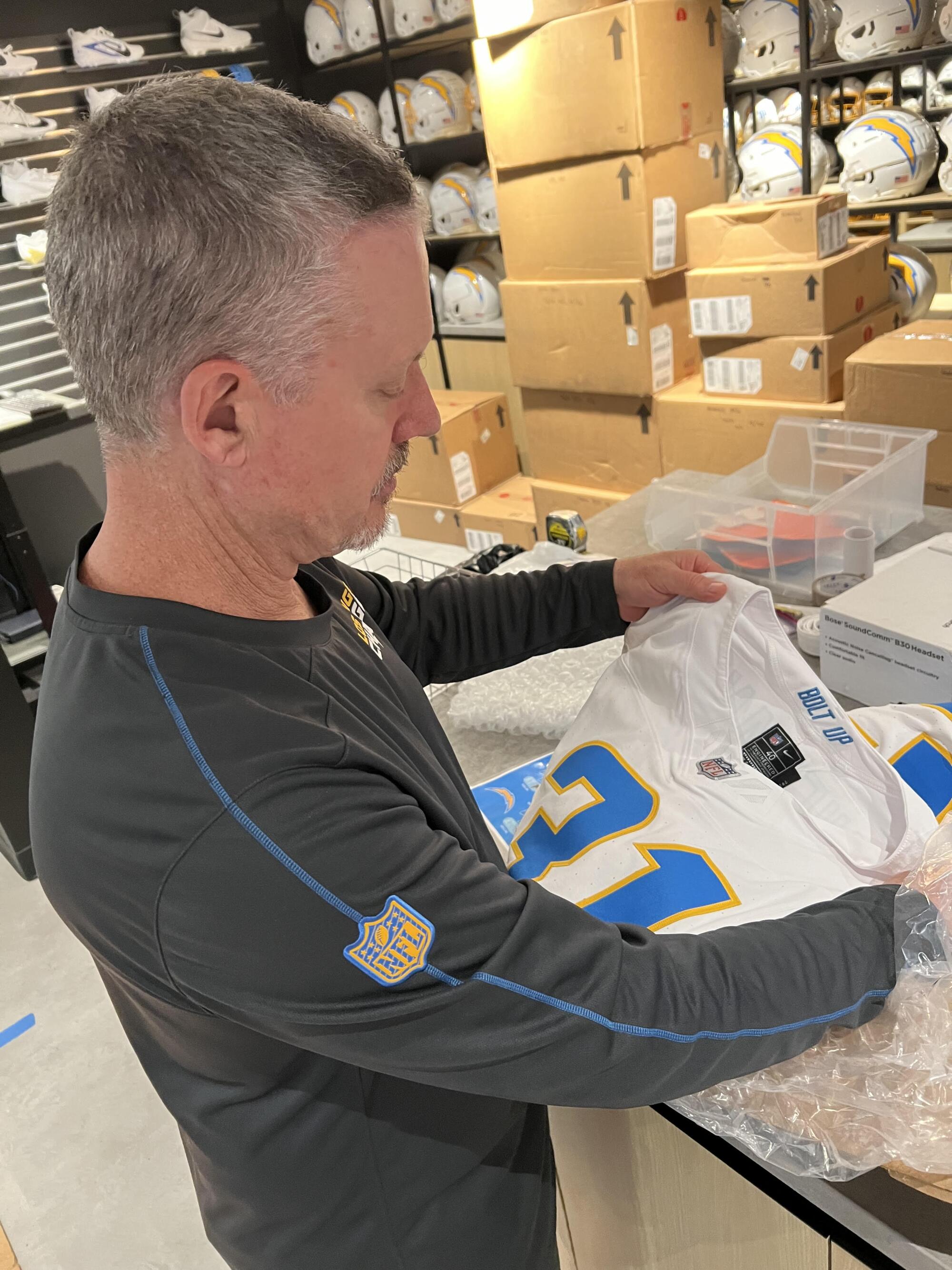
Smith, who grew up in Camarillo, was a student-manager at San Diego State in 1990 when he got the call to be a ball boy at Chargers games. He had planned to be a teacher and coach high school football, but quickly caught the NFL bug.
“Once I got in I thought, ‘Oh man, this is what I want to do.’”
Back then, the Chargers had an equipment staff of three full-time employees, and one or two people to help work practice. By comparison, his current crew is four full-time employees, three seasonal interns and one part-timer who comes in at night to do laundry.
On game day, Smith’s staff expands to 19 people, including five on the chain crew, five on the ball crew — those who get the footballs to officials during the game — and eight people working the visitors’ locker room. Another person is assigned to the officials’ locker room.
Some of his workers have pretty impressive resumes away from the game. On his ball crew he has a dentist, an account and a jet-propulsion engineer.

Big Brother is watching.
There’s a barcode in every Chargers helmet, set of shoulder pads and pair of cleats, and when players head out to practice they pass through a scanner that records which items are in use and sends that information to the NFL. It’s all in the name of making the game safer by relying on the best equipment.
“If you’re missing guys, the league will say, `Hey, you’re missing 10 helmets from yesterday’s practice,’” Smith said. “Then you’ve got to go back and scan them in by hand.”
There are multiple portals with those sensors in the training facility and at SoFi Stadium. The information is transmitted via barcodes and Radio Frequency ID (RFID) chips.
“The league’s got their hands all over this,” Smith said. “But that’s good because a guy should be wearing the right stuff.”
The NFL is a copycat league, and that doesn’t just refer to coaches duplicating the ideas of other coaches.
“Sometimes I’ll see a guy wearing something in a game and I’m like, ‘Oh, don’t do that,’” Smith said. “Especially if it’s a big-time player. We’ll text each other, ‘Did you see what so-and-so’s wearing?’ Now everybody wants to do it. It’s very trendy.”
A player might have a different cut to the sleeves of his jersey or a zig-zagging facemask.
“Then the league will come back and say you can only have this many bars on your facemask,” he said. “They’re always trying to squash some of this stuff.”
Equipment assistant Chad Jessop shows what the Chargers do to prep balls for games and practices. (Sam Farmer / Los Angeles Times)
There’s an art to preparing footballs and Chad Jessop is a budding Picasso.
In a day and a half he can transform a waxy, light-brown football that’s fresh out of the box into a mahogany gem that feels like a perfectly worked-in baseball glove. That involves treating the surface of the ball with the same oil that’s used on horse saddles, then in succession leather balm, conditioner, mud, more conditioner, and a thorough brushing.
“The mud is the hardest part,” he said. “It takes me seven minutes to remove the mud from the ball, and that’s using the electric brush. Some guys prefer to do it manually, and it can take considerably longer.”
Jessop works closely with quarterback Justin Herbert to get the footballs just the way he wants them, just as Smith did for Philip Rivers, Drew Brees, Doug Flutie and others.
On game day, the Chargers report to the locker room with 24 footballs — 12 game balls, 12 backups — and each ball is individually numbered. Implanted in each ball bladder is an RFID chip that allows for Next Gen Stats’ collection of all types of statistical data.
Each team has been issued 290 chipped game balls for the 2024 season and has to make those balls last for the entire schedule.
“You lose them if there’s an interception,” Jessop said. “You lose them if there’s a milestone moment. You do everything you can not to lose these footballs.”
Some teams have different jerseys for practices and games.
That’s not the way of Chargers coach Jim Harbaugh.
The Chargers wear their game jerseys in practice so their players can get used to the feel of them. John Harbaugh does that with the Baltimore Ravens, and Jim does it with the Chargers, just as he did at the University of Michigan.
Chris Smith, head equipment manager for Chargers, demonstrates how shoe size and brand are determined for every player on the team. (Sam Farmer / Los Angeles Times)
Not every player wears the same kind of helmet. There are five helmet vendors and a wide array of models that are all “in the green,” meaning they’ve passed the NFL’s rigorous testing standards.
Some helmets are Corvette sleek. Some are better ventilated. Some have shells that flex like plastic car bumpers.
A couple models are sufficiently protective that the wearers don’t have to practice with Guardian Caps, the soft-shell covers that fit over standard helmets to provide additional cushion and protection.
“I find that linemen don’t care as much about the look of the helmets,” Smith said. “The skill position players care more about the look.”
The helmets are custom-fitted, with representatives from those companies mapping the contours of a player’s head to create the perfect padding for comfort and protection. Harbaugh even allows them to take those measurements in team meetings.
Same goes for cleats, although the Chargers have the technology to do that foot mapping in house.
Shoe companies pay big money for sponsorship deals, so they don’t want their players covering logos with tape. Hall of Fame receiver Jerry Rice — whose son, Brenden, is a Chargers rookie — was the only player Nike allowed to “spat” back in the day. That’s when a player has a heavy layer of tape covering his ankles and wrapping outside the shoe around the arch of his foot.
Ted Walsh, former assistant equipment manager for the San Francisco 49ers, got so good at inking the Nike swoosh that he could draw it in the dark. He would then sign the bottom of Rice’s cleats.
That kind of stuff doesn’t happen anymore. The league doesn’t allow drawn-on logos.
Win or lose, there’s a mountain of mesh bags after every game. Each bag is assigned to a player and contains everything that person wore under his uniform — compression shirts, girdles, tights, socks, skull caps.
The ensemble is called a “loop,” because some people actually hang it on a plastic loop. The equipment crew washes and neatly folds all the garments, returning them to the mesh bag. Sometimes that requires fixing tears to the fabric and scrubbing out grass stains.
Chris Smith, director of equipment operations for the Chargers, shows what a typical player might have in his game-day bag. (Sam Farmer / Los Angeles Times)
The old days were different. Former Cincinnati quarterback Boomer Esiason remembers when the Bengals equipment crew would wheel out two canvas laundry carts each day — one filled with socks and the other with jock straps.
Getting ready for practice meant fishing around to find matching socks then grabbing a random jock. Players called the place “the kennel” because of the chain-link lockers.
The jocks-and-socks routine is part of the distant past.
“We want to make it as easy on the players as possible,” said Tasso Panopoulos, whose many responsibilities with the Chargers include having the loops ready to go. “We want it so they get in on Sunday, have everything they need and just grab it and go. No distractions.”
Some players wear garments under their pads for sentimental reasons. Former Chargers defensive tackle Christian Covington had worn the same cutoff sweatshirt under his pads since high school.
“It was literally falling apart,” Smith said. “When he left here last year he left it for us. We didn’t even know. It was on a hanger and he wrote a note, `You guys are the best. Love you guys.’”
Not surprisingly, game day is the busiest day of the week for the equipment crew.
But what about their craziest day of the year? That’s when the rookies report for the first time. Thirty players getting custom fitted for helmets, shoulder pads and cleats. It’s an assembly line.
“We try to get the sizing information from colleges,” Smith said. “Some of the big schools do it — Alabama, Notre Dame, Georgia. But you’ll ask some of the smaller schools and they’ll say, ‘He’s an XL.’
“That means nothing to us.”
Coaches switch teams all the time. Some have worked for half the teams in the NFL.
Not so for equipment managers. It’s common for them to come up through the ranks of an organization and stay with the same team for an entire career.
It’s uncommon for an equipment manager to work for multiple NFL teams, or to jump from college to the pros, although that’s what Brendan Burger did when he left UCLA to join the Rams.
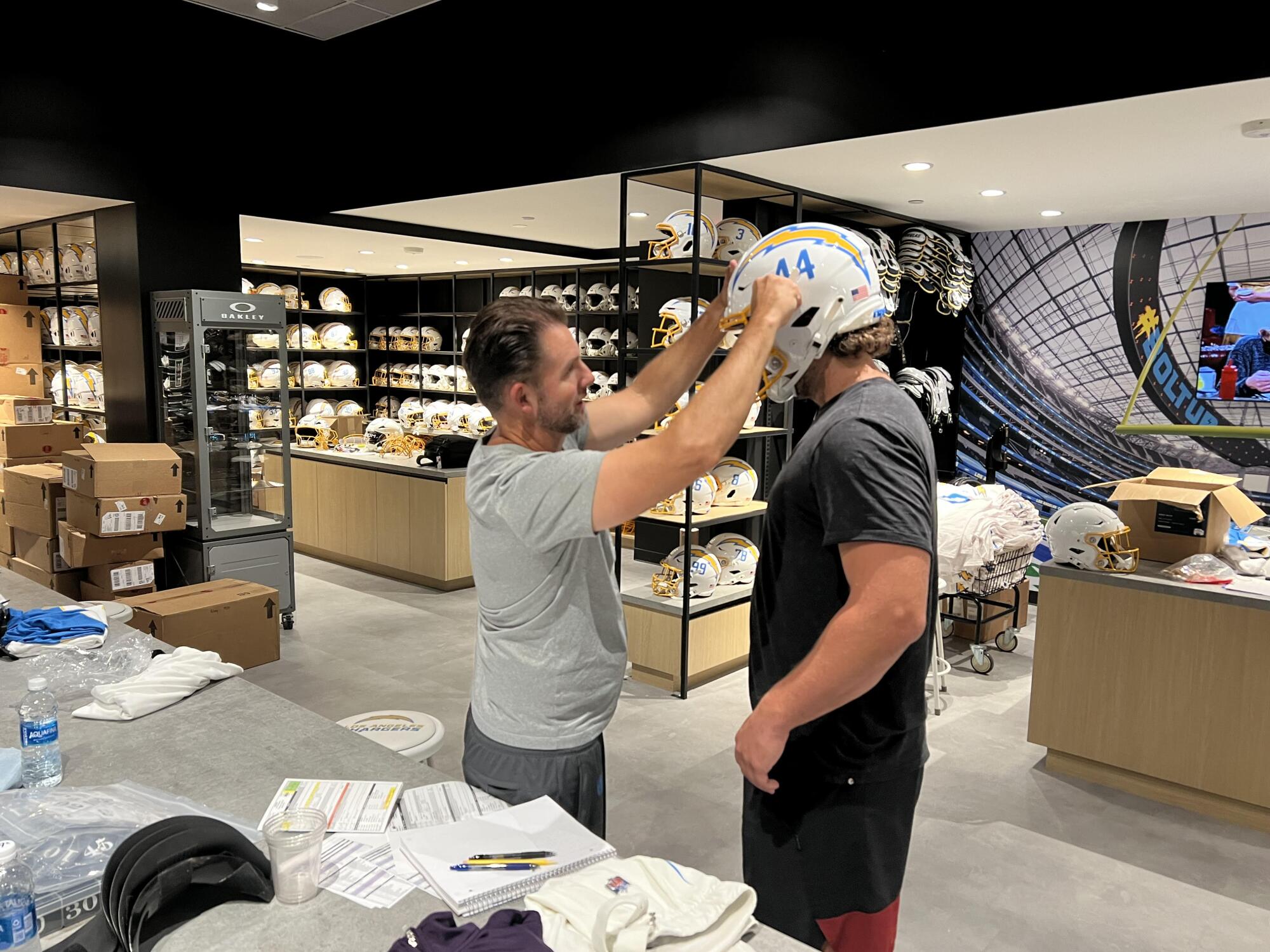
Duddy has worked for the Chargers since 1993, when he was a junior in high school and working as a ball boy at training camp. Now, his responsibilities include overseeing the packing for games, timing the sessions in practice and helping warm up the quarterbacks.
He also sets up the coach-to-quarterback radio system, which is pretty high tech these days. It was a more rudimentary system in the past, requiring him to arrange a bouquet of antennas, often mounted off the edge of the press box.
Once, during a game in St. Louis, the radio signal suddenly disappeared mid-game. Frantic, Duddy sprinted up the stairs to the press box to fix the problem. When he got up there, he discovered someone had unplugged the system in order to plug in a laptop.
“Little did that person know,” he said, “that person killed both our signal and the Rams’ signal.”
At training camp, it was Duddy’s job to transport dejected players to the airport.
“I’d have a vanload of guys who had just got cut from the team,” he said. “That was a quiet ride.”
More to Read
Go beyond the scoreboard
Get the latest on L.A.'s teams in the daily Sports Report newsletter.
You may occasionally receive promotional content from the Los Angeles Times.

